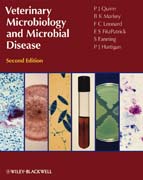
Veterinary microbiology and microbial disease
Quinn, P.J.
Markey, B.K.
Leonard, F.C.
Veterinary microbiology is one of the core subjects for veterinary students. Fully revised and expanded, this new edition covers every aspect of veterinarymicrobiology for students in both paraclinical and clinical years. It provides concise descriptions of the groups of micro-organisms, diseases they produce, immunological aspects and a summary of infectious diseases based on their main clinical signs. New to this edition: Diagrams throughout showing the transmission of infection New chapters on the application of molecular methods, foodsafety and public health, skin, the respiratory system, cardiology, and the urinary tract Revisions to existing text and many more illustrations INDICE: Preface. Acknowledgements. Author biographies. Section I: Introduction to Microbiology, Infection, Immunity and Molecular Diagnostic Methods. 1 Microbiology, microbial pathogens and infectious disease. 2 Subdivisions, classification and morphological characterization of infectious agents. 3 Infection and immunity. 4 Immunodeficiency diseases. 5 Vaccines and vaccination. 6 Molecular diagnostic methods. Section II: Introductory Bacteriology. 7 The structure of bacterial cells. 8 Cultivation, preservation and inactivation of bacteria. 9 Bacterial genetics, mechanisms of genetic variation and gene databases. 10 Laboratory diagnosis of bacterial disease. 11 Antibacterial agents. 12 Antibacterial resistance. 13 Bacterial colonization, tissue invasion and clinical disease. Section III: Pathogenic Bacteria. 14 Staphylococcus species. 15 Streptococci. 16 Actinobacteria. 17 Corynebacterium species. 18 Rhodococcus equi. 19 Listeria species. 20 Erysipelothrix rhusiopathiae. 21 Bacillus species. 22 Clostridium species. 23 Mycobacterium species. 24 Enterobacteriaceae. 25 Pseudomonas aeruginosa and Burkholderia species. 26 Actinobacillus species. 27 Pasteurella species, Mannheimia haemolytica and Bibersteinia trehalosi. 28 Francisella tularensis. 29 Histophilus somni, Haemophilus parasuis and Avibacterium paragallinarum. 30 Taylorella species. 31 Bordetella species. 32 Moraxella species. 33 Brucella species. 34 Campylobacter and Helicobacter species. 35 Lawsonia intracellularis. 36 Spirochaetes. 37 Pathogenic anaerobic non-spore-forming Gram-negative bacteria. 38 Mycoplasmas. 39 Chlamydia and Chlamydophila species. 40 Rickettsiales and Coxiella burnetii. 41 Bacterial species of limited pathogenic significance. Section IV: Mycology. 42 General features of fungi associated with disease in animals. 43 Dermatophytes. 44 Aspergillus species. 45 Yeasts and disease production. 46 Dimorphic fungi. 47 Zygomycetes of veterinary importance. 48 Fungus-like organisms of veterinary importance. 49 Pneumocystis carinii. 50 Opportunistic infections caused predominantly by phaeoid fungi. 51Mycotoxins and mycotoxicoses. 52 Pathogenic algae and cyanobacteria. 53 Antifungal chemotherapy. Section V: Introductory Virology. 54 Nature, structure andtaxonomy of viruses. 55 Replication of viruses. 56 Genetics and evolution of viruses. 57 Propagation of viruses and viruscell interactions. 58 Pathogenesisof viral diseases. 59 Laboratory diagnosis of viral infections. 60 Antiviral chemotherapy. Section VI: Viruses and Prions. 61 Herpesviridae. 62 Papillomaviridae. 63 Adenoviridae. 64 Poxviridae. 65 Asfarviridae. 66 Parvoviridae. 67 Circoviridae. 68 Retroviridae. 69 Reoviridae. 70 Birnaviridae. 71 Orthomyxoviridae. 72 Paramyxoviridae. 73 Rhabdoviridae. 74 Bornaviridae. 75 Bunyaviridae. 76Picornaviridae. 77 Caliciviridae. 78 Astroviridae. 79 Coronaviridae. 80 Arteriviridae. 81 Flaviviridae. 82 Togaviridae. 83 Prions: unconventional infectious agents. Section VII: Microbial Agents and D
- ISBN: 978-1-4051-5823-7
- Editorial: Wiley-Blackwell
- Encuadernacion: Rústica
- Páginas: 912
- Fecha Publicación: 22/07/2011
- Nº Volúmenes: 1
- Idioma: Inglés
